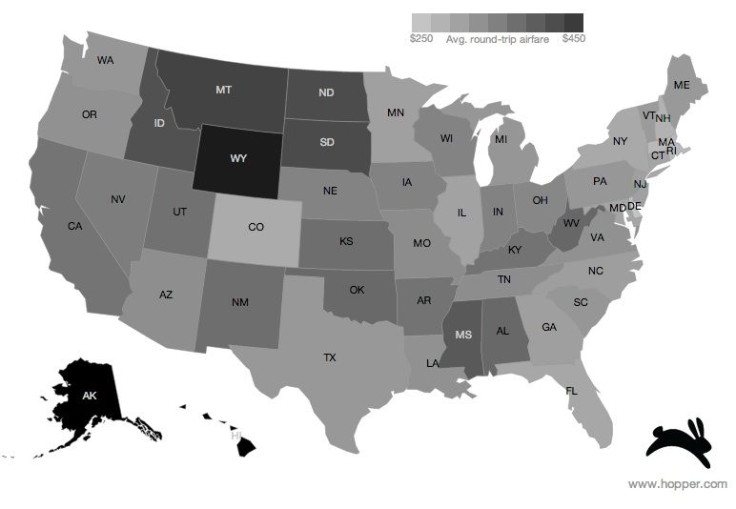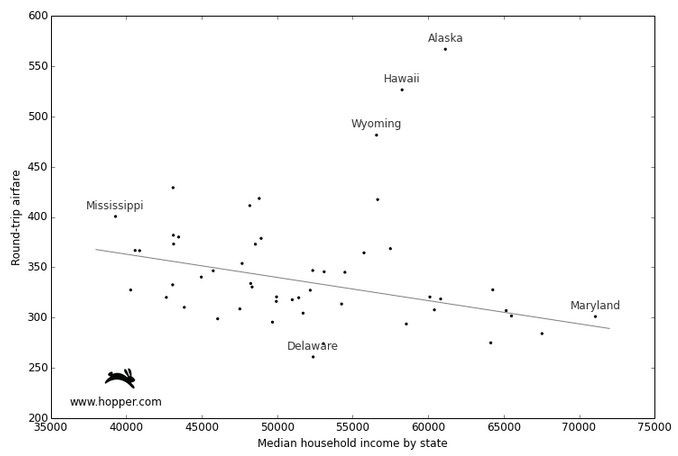Why Residents Of Lower-Income States Pay More For Airfare

Being poor isn’t cheap. That’s the message behind a new report from Boston-based trip planning startup Hopper, which revealed that residents of lower-income U.S. states pay up to $150 more for a round-trip plane ticket.
Hopper looked at the cheapest 10 percent of aggregated flight search data to find what sort of airfare someone in each state could get if they were searching for a “good deal.” In the end, researchers found that the typical round-trip ticket in the U.S. declined by $2.30 for every additional $1,000 in median household income, suggesting that richer states have cheaper flights, while poorer states fork over significantly higher sums for the luxury of travel.
“Lower-income states have less-competitive air travel markets,” Patrick Surry, chief data scientist at Hopper, explained. Yet, the observed correlation with household income disappears once you allow for factors like demand density, average number of airline choices and expected number of stops on the routes people are looking for. “The latter two are directly driven by competition: How well served are you by direct flights? Are you always routed via hubs? How many choices of airline do you have?”
Surry said there is a positive feedback loop where states with a good economy tend to have more demand, which also stimulates the economy. “Per capita demand increases with household income, and more densely populated states are cheaper to serve,” he said. “Population density is also correlated to household income -- more prosperous states attract more people, increasing demand and density.”
Wyoming, it seems, has a particularly bad combination of low demand density and low service. Hopper found that the Cowboy State had the most expensive airfares in the continental U.S. because it had the fewest airline choices per route (an average of 2.5) and the highest average number of stopovers (just over 1).
Neighboring Montana, Idaho, North Dakota and South Dakota similarly had average round-trip airfares that soared above $400 because, as Hopper explained, lower demand makes it harder to fill airplanes and a dispersed population makes it harder to fill airports.

The two U.S. states with the lowest median household income, Mississippi and West Virginia, had some of the nation’s highest round-trip airfares at $400.57 and $381.87 respectively. On the flip side, residents of Delaware had the absolute lowest average round-trip fares in the U.S. at just $260.77, followed by Rhode Island ($274) and Massachusetts ($274.82). Colorado, meanwhile, was the only state not on the East Coast with average round-trip flights available for less than $300.
In general, the densely populated and wealthier states of the Northeast Corridor have some of the nation’s cheapest flights thanks to high population density, high demand, a healthy business travel market and a large number of competing airlines.
“Several of the largest airports in the northeast -- Boston Logan, Newark, New York LaGuardia, New York JFK -- are interesting in that they’re not really ‘hubs’ in the sense of being dominated by a single airline, but instead are very diverse jumping off points for cross-country and international flights,” Surry explained. “We used a very simple measure of competition in terms of expected number of airline choices per route, but it would be interesting to look at whether that sometimes masks the fact that really one airline is dominating your potential options.”
Surry said he thinks an improving economy will lead to better demand and competition, “but it will take time before airlines can respond to it.”
“Our advice [to those in underserved markets] is to become an informed consumer,” he said. “Book as far in advance as you can, be as flexible as possible on your dates and destination, and check alternative arrival and departure airports. Even some not so nearby might give significant savings.”
Other Findings From The Hopper Study
-The three states with the most expensive roundtrip airfares are Alaska ($567), Hawaii ($526) and Wyoming ($429)
-The four states that face the highest airfare premiums due to lack of competition are Wyoming (+$167), Louisiana (+$138), Nevada (+$130) and South Carolina (+$119)
- Residents of Mississippi, the state with the lowest median income, pay about $400 for a round-trip flight. Residents of Maryland, with the highest income, pay about $300.
© Copyright IBTimes 2024. All rights reserved.






















